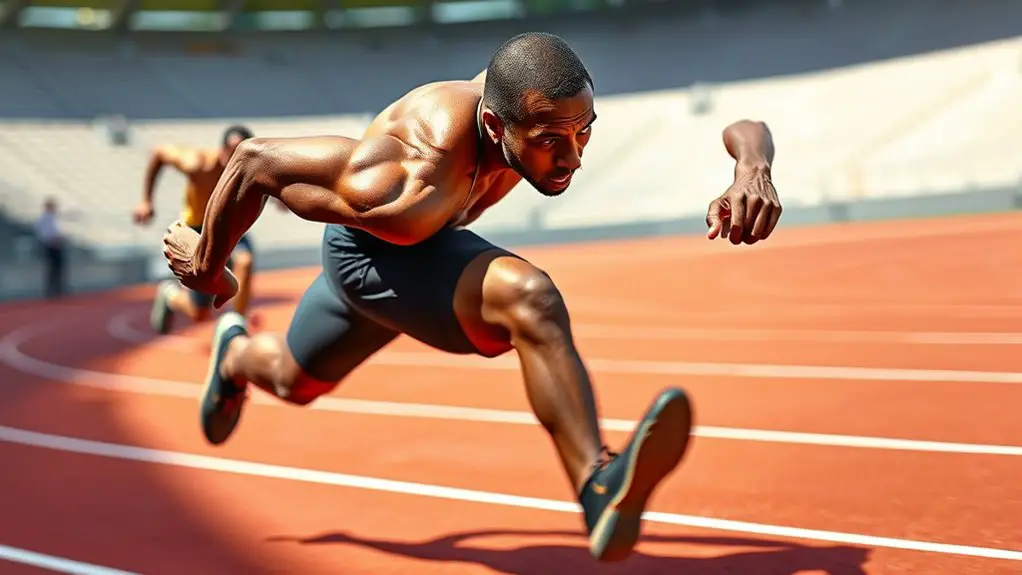Arm mechanics play an essential role in your sprinting efficiency. A well-coordinated arm swing enhances your rhythm and complements leg motion, which can boost your overall speed and performance. When arms and legs work in sync, you achieve better momentum and energy conservation. Maintaining a 90-degree elbow angle and relaxed shoulders improves propulsion and stability. Focusing on arm dynamics can elevate your sprinting. Stick around to discover more techniques for optimizing your arm movement.
The Importance of Arm Movement in Sprinting
When you sprint, you might not realize how essential your arm movement is to your overall efficiency. Your arm rhythm plays a significant role in maintaining proper sprint alignment, helping you achieve that exhilarating sense of freedom as you race forward. As you drive your arms back and forth, they create momentum that propels your legs to move faster. If your arms are stiff or uncoordinated, it disrupts your balance and slows you down.
To harness the freedom of sprinting, focus on a fluid arm movement that complements your stride. Imagine your arms working in harmony with your legs, allowing your body to flow effortlessly. Proper arm positioning not only enhances your speed but also supports your posture, keeping you aligned and powerful. Additionally, incorporating technique work into your training can further optimize your sprinting efficiency. So, next time you hit the track, remember that your arms are more than just accessories—they're essential partners in your quest for speed and freedom.
Understanding the Mechanics of Arm Swing
While you might focus primarily on your legs during a sprint, the mechanics of your arm swing are just as significant to your performance. Your arms play a vital role in driving your body forward, and understanding this can reveal newfound speed and efficiency. Through biomechanics analysis, you can learn how a coordinated arm swing complements your leg movements, enhancing your overall rhythm.
When your arms move in sync with your legs, you create balance and momentum, allowing for a more fluid running style. The natural opposition of your arm swing helps stabilize your torso, preventing unnecessary lateral movement that could slow you down. Try to keep your elbows bent at about 90 degrees and swing your arms from your shoulders, not just your hands. This will maximize the power of your arm swing, contributing to a more dynamic sprint. Incorporating proper sprinting technique will further enhance your performance and ensure that your arm mechanics are effectively utilized. Embrace these mechanics, and you'll feel the difference in your performance.
How Arm Position Affects Balance and Stability
The position of your arms during a sprint plays a significant role in maintaining balance and stability. Proper arm alignment helps you counteract the natural torque generated by your legs. When your upper body is aligned, your arms can effectively counterbalance your leg movements, allowing you to sprint with greater freedom and efficiency.
If your arms swing too high or low, it can throw your body off balance, leading to wasted energy and a loss of speed. Keeping your elbows bent at about 90 degrees and driving your arms back and forth in rhythm with your legs helps maintain that vital alignment. This not only stabilizes your form but also allows your entire body to work in harmony. Additionally, incorporating agility training techniques can enhance your overall sprinting performance.
Ultimately, a well-positioned upper body supports your overall sprinting technique, ensuring you harness your full potential and achieve your racing goals.
The Relationship Between Arm Drive and Leg Power
Although many focus solely on leg strength for sprinting performance, the relationship between arm drive and leg power is equally essential. You might not realize that your arm power plays a critical role in propelling your body forward. When you pump your arms with intensity, it creates momentum that enhances leg synchronization. This means that the more effectively your arms move, the better your legs can perform.
Picture this: as your arms swing forward, they help generate forward motion, allowing your legs to follow suit more efficiently. The harmony between your arm movements and leg actions can greatly influence your sprinting speed. By harnessing the power of your arms, you're not just adding another element to your sprint; you're creating a powerful synergy that can elevate your performance. Additionally, incorporating footwork drills into your training can further enhance your overall speed and coordination. So, next time you're on the track, remember that every swing of your arm is a step toward freedom in your running.
Techniques for Optimizing Arm Movement
To maximize your sprinting efficiency, focusing on your arm movement is essential. Proper arm movement optimization can greatly enhance your overall performance. Start by keeping your elbows bent at about 90 degrees, allowing for a natural swing. As you sprint, drive your arms forward and back in sync with your legs; this coordination fuels your propulsion.
Aim for a relaxed grip—tension can slow you down. Use your shoulders to initiate movement, keeping them low and steady. Remember, your arms should move in a straight line, so avoid crossing them over your body, which can waste energy.
Incorporate sprinting technique enhancements like drills that emphasize arm swings. Practicing with resistance bands can also build strength and improve your form. Finally, visualize your arm movement while running; this mental focus helps solidify the techniques in your muscle memory, leading to more efficient sprints and a greater sense of freedom on the track. Additionally, proper footwork is crucial in maintaining balance and stability, which complements your arm mechanics for optimal sprinting performance.
Common Mistakes in Arm Mechanics During Sprinting
When sprinting, you might not realize how improper arm swing can throw off your rhythm and speed. Tension in your shoulders can also hinder your performance, making it harder to maintain an efficient stride. Core strength plays a crucial role in stabilizing your upper body, allowing for more controlled and powerful arm movements that enhance your overall sprinting efficiency. Let's explore these common mistakes and how they can impact your overall sprinting efficiency.
Improper Arm Swing
Improper arm swing can considerably hinder your sprinting efficiency, as many runners underestimate its importance. When your arms aren't moving correctly, it can lead to excessive movement and ultimately, arm fatigue. Here are three common mistakes to avoid:
- Crossing the Body: Swinging your arms across your chest can throw off your balance and rhythm.
- Overextending: When your arms swing too far back or forward, it takes energy away from your legs, slowing you down.
- Rigid Movements: Tensing your arms can create unnecessary resistance, making it harder to maintain speed.
Tension in Shoulders
While you might focus on your legs and overall speed, the tension in your shoulders can greatly impact your sprinting performance. If you're gripping your shoulders too tightly, it can lead to unnecessary arm tension, which can slow you down. Instead, prioritize shoulder relaxation to enhance your speed and efficiency.
Here's a quick guide to help you assess your shoulder tension:
| Tension Level | Effects on Sprinting | Solutions |
|---|---|---|
| High Tension | Decreased arm swing | Practice relaxation |
| Moderate Tension | Slightly restricted motion | Focus on form |
| Low Tension | peak performance | Maintain awareness |
| No Tension | Freer, more fluid motion | Regular check-ins |
The Impact of Arm Mechanics on Overall Sprint Performance
Your arm swing plays an essential role in how efficiently you sprint. When your arms coordinate well with your leg motion, it can considerably boost your speed and overall performance. By optimizing your arm mechanics, you can enhance your energy efficiency and get the most out of every stride. Maintaining proper arm movement is crucial for maximizing forward momentum and stability during your sprint.
Arm Swing Dynamics
Arm swing dynamics play an essential role in sprinting efficiency, as the way you move your arms can greatly influence your overall speed and stability. When you understand the biomechanics analysis of your arm swing, you'll see how it can elevate your performance. Here are three key factors to take into account:
- Angle and Motion: Your arms should drive forward and back at about a 90-degree angle to maximize propulsion.
- Synchronization: A coordinated arm swing helps maintain rhythm, enhancing your leg motion without wasting energy.
- Relaxation: Keeping your shoulders relaxed while swinging your arms allows for a more fluid movement, reducing resistance.
Coordination With Leg Motion
Effective coordination between arm and leg motion is essential for maximizing sprint performance, as they work in tandem to generate speed and maintain balance. When you achieve ideal arm leg synchronization, you create a rhythm that enhances your dynamic motion. Your arms drive forward as your legs push off the ground, allowing you to harness the full potential of each stride. If your arm movement is out of sync with your leg motion, you may find yourself losing speed or stability. By focusing on the fluidity of these movements, you can improve your overall efficiency, making each sprint feel more effortless. Embrace this connection, and you'll find that your runs become more powerful and liberating.
Energy Efficiency Optimization
While sprinting, the mechanics of your arms can greatly influence energy efficiency, impacting your overall performance. By focusing on arm movement, you can implement effective energy conservation strategies. Here are three key aspects to take into account:
- Arm Swing: Keep your arms relaxed and swinging in sync with your legs to maximize propulsion.
- Elbow Position: Maintain a 90-degree angle at the elbow, which allows for powerful, efficient movement without wasting energy.
- Core Engagement: Activate your core during your sprint; a strong core stabilizes your body and enhances your biomechanics analysis for peak efficiency.
Frequently Asked Questions
How Does Arm Length Influence Sprinting Efficiency?
Imagine running like a gazelle, graceful and swift. Your arm length plays a vital role in that image, affecting your arm reach and how you harness speed dynamics. Longer arms can enhance your stride, allowing for a more powerful push-off and better balance. This freedom in movement can translate to greater efficiency, letting you glide through each sprint with ease. So, consider how your unique build can elevate your running game.
Can Arm Mechanics Prevent Common Sprinting Injuries?
Good arm mechanics can play a vital role in injury prevention while sprinting. When you focus on proper arm positioning, it helps maintain balance and reduces strain on your body. As you run, keeping your arms aligned and relaxed allows for a smoother stride, which can lower the risk of common injuries. So, by paying attention to how you move your arms, you can enjoy the freedom of sprinting without the worry of injuries.
What Role Does Shoulder Flexibility Play in Sprinting?
Imagine a bird soaring freely through the sky; that's how you should feel when sprinting. Shoulder flexibility plays an essential role in your performance, as it allows for ideal shoulder rotation and a powerful arm swing. When your shoulders are loose, you can move more freely, enhancing your speed and efficiency. So, embrace those stretches, and feel the freedom of each stride, propelling you forward with every sprint.
Are There Specific Drills to Improve Arm Mechanics?
Absolutely, there are specific drills to improve your arm mechanics! You can try drill variations like high-knee skips, where you focus on arm swing while keeping your shoulders relaxed. Another great option is the "A" skip, emphasizing a rhythmic arm movement. These exercises not only enhance your arm swing but also promote better coordination. Incorporating these into your training routine can really free up your upper body, leading to more efficient sprinting!
How Do Arm Mechanics Differ Between Sprinters and Distance Runners?
Arm mechanics differ considerably between sprinters and distance runners. As a sprinter, your arm movement is more explosive, focusing on quick, powerful swings that enhance energy transfer to your legs. In contrast, distance runners use a smoother, more relaxed arm motion to conserve energy and maintain endurance. By understanding these differences, you can appreciate how each style helps optimize performance, allowing you to express your freedom of movement in your chosen discipline.




